2014 MERCEDES-BENZ GL ESP inoperative
[x] Cancel search: ESP inoperativePage 46 of 462
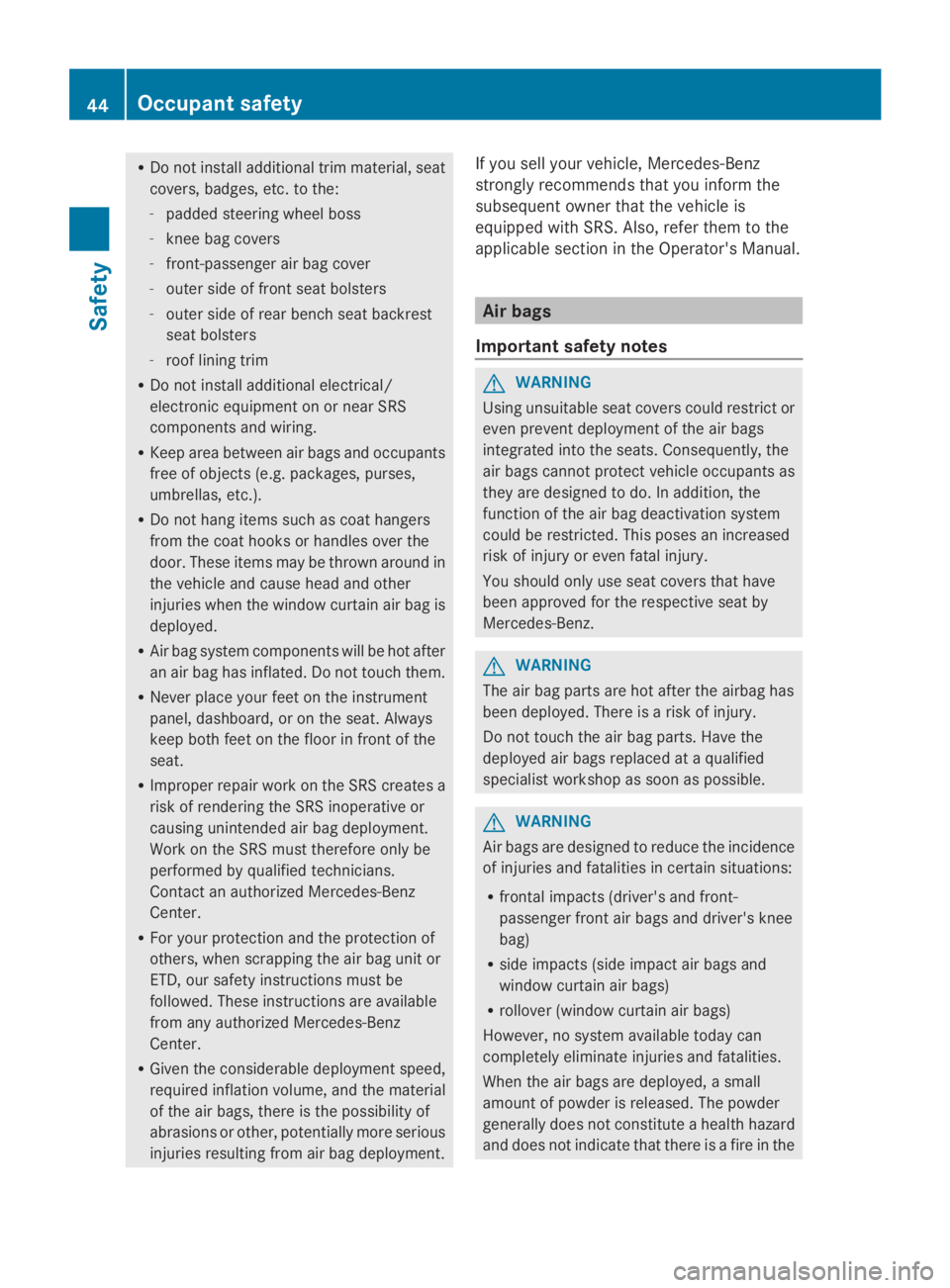
RDo not install additional trim material, seat
covers, badges, etc. to the:
-padded steering wheel boss
-knee bag covers
-front-passenger air bag cover
-outer side of front seat bolsters
-outer side of rear bench seat backrest
seat bolsters
-roof lining trim
RDo not install additional electrical/
electronic equipment on or near SRS
components and wiring.
RKeep area between air bags and occupants
free of objects (e.g. packages, purses,
umbrellas, etc.).
RDo not hang items such as coat hangers
from the coat hooks or handles over the
door. These items may be thrown around in
the vehicle and cause head and other
injuries when the window curtain air bag is
deployed.
RAir bag system components will be hot after
an air bag has inflated. Do not touch them.
RNever place your feet on the instrument
panel, dashboard, or on the seat. Always
keep both feet on the floor in front of the
seat.
RImproper repair work on the SRS creates a
risk of rendering the SRS inoperative or
causing unintended air bag deployment.
Work on the SRS must therefore only be
performed by qualified technicians.
Contact an authorized Mercedes-Benz
Center.
RFor your protection and the protection of
others, when scrapping the air bag unit or
ETD, our safety instructions must be
followed. These instructions are available
from any authorized Mercedes-Benz
Center.
RGiven the considerable deployment speed,
required inflation volume, and the material
of the air bags, there is the possibility of
abrasions or other, potentially more serious
injuries resulting from air bag deployment.
If you sell your vehicle, Mercedes-Benz
strongly recommends that you inform the
subsequent owner that the vehicle is
equipped with SRS. Also, refer them to the
applicable section in the Operator's Manual.
Air bags
Important safety notes
GWARNING
Using unsuitable seat covers could restrict or
even prevent deployment of the air bags
integrated into the seats. Consequently, the
air bags cannot protect vehicle occupants as
they are designed to do. In addition, the
function of the air bag deactivation system
could be restricted. This poses an increased
risk of injury or even fatal injury.
You should only use seat covers that have
been approved for the respective seat by
Mercedes-Benz.
GWARNING
The air bag parts are hot after the airbag has
been deployed. There is a risk of injury.
Do not touch the air bag parts. Have the
deployed air bags replaced at a qualified
specialist workshop as soon as possible.
GWARNING
Air bags are designed to reduce the incidence
of injuries and fatalities in certain situations:
Rfrontal impacts (driver's and front-
passenger front air bags and driver's knee
bag)
Rside impacts (side impact air bags and
window curtain air bags)
Rrollover (window curtain air bags)
However, no system available today can
completely eliminate injuries and fatalities.
When the air bags are deployed, a small
amount of powder is released. The powder
generally does not constitute a health hazard
and does not indicate that there is a fire in the
44Occupant safety
Safety
Page 69 of 462
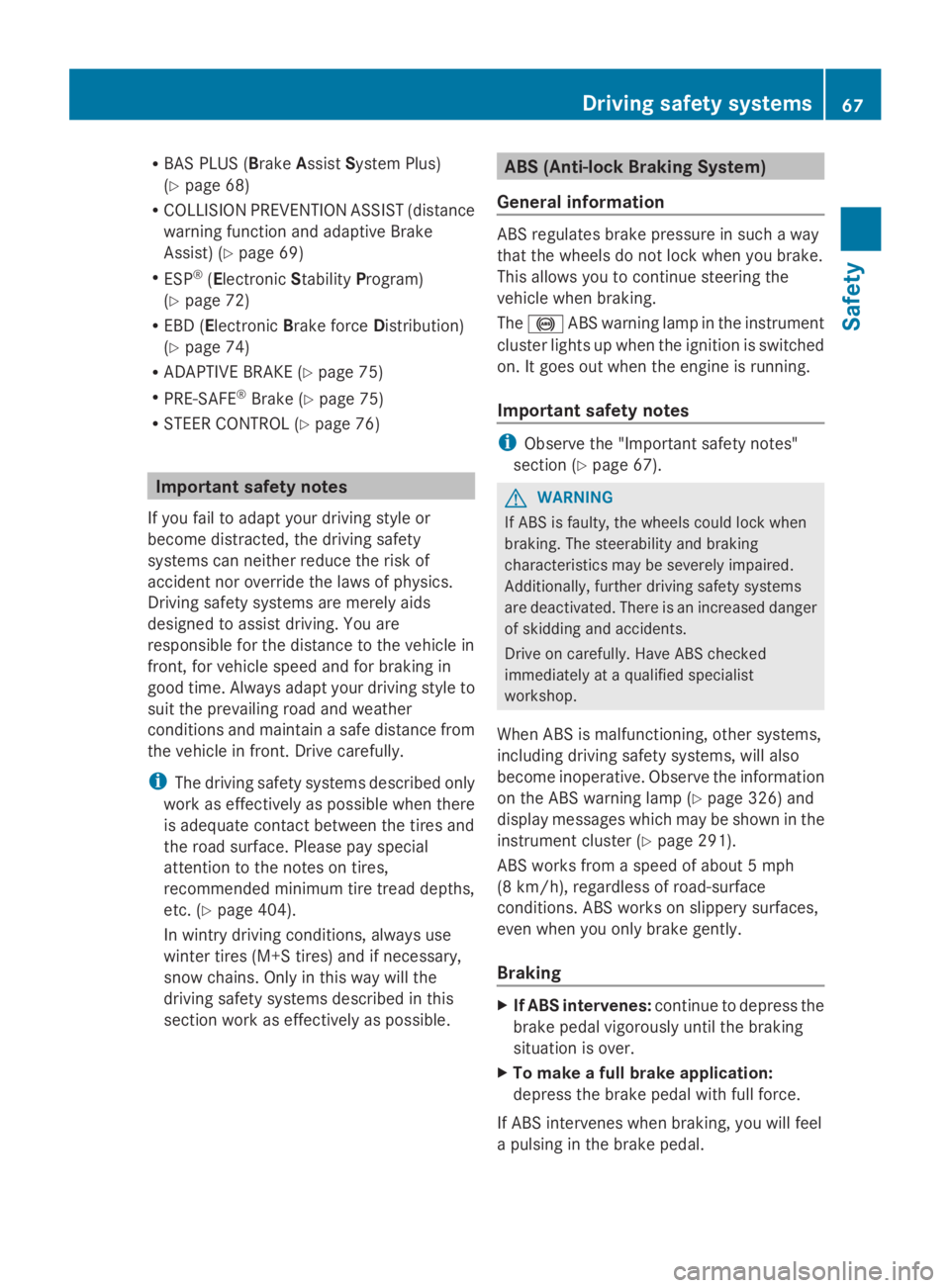
RBAS PLUS (BrakeAssistSystem Plus)
(Ypage 68)
RCOLLISION PREVENTION ASSIST (distance
warning function and adaptive Brake
Assist) (Ypage 69)
RESP®(ElectronicStabilityProgram)
(Ypage 72)
REBD (ElectronicBrake forceDistribution)
(Ypage 74)
RADAPTIVE BRAKE (Ypage 75)
RPRE-SAFE®Brake (Ypage 75)
RSTEER CONTROL (Ypage 76)
Important safety notes
If you fail to adapt your driving style or
become distracted, the driving safety
systems can neither reduce the risk of
accident nor override the laws of physics.
Driving safety systems are merely aids
designed to assist driving. You are
responsible for the distance to the vehicle in
front, for vehicle speed and for braking in
good time. Always adapt your driving style to
suit the prevailing road and weather
conditions and maintain a safe distance from
the vehicle in front. Drive carefully.
iThe driving safety systems described only
work as effectively as possible when there
is adequate contact between the tires and
the road surface. Please pay special
attention to the notes on tires,
recommended minimum tire tread depths,
etc. (Ypage 404).
In wintry driving conditions, always use
winter tires (M+S tires) and if necessary,
snow chains. Only in this way will the
driving safety systems described in this
section work as effectively as possible.
ABS (Anti-lock Braking System)
General information
ABS regulates brake pressure in such a way
that the wheels do not lock when you brake.
This allows you to continue steering the
vehicle when braking.
The�%ABS warning lamp in the instrument
cluster lights up when the ignition is switched
on. It goes out when the engine is running.
Important safety notes
iObserve the "Important safety notes"
section (Ypage 67).
GWARNING
If ABS is faulty, the wheels could lock when
braking. The steerability and braking
characteristics may be severely impaired.
Additionally, further driving safety systems
are deactivated. There is an increased danger
of skidding and accidents.
Drive on carefully. Have ABS checked
immediately at a qualified specialist
workshop.
When ABS is malfunctioning, other systems,
including driving safety systems, will also
become inoperative. Observe the information
on the ABS warning lamp (Ypage 326) and
display messages which may be shown in the
instrument cluster (Ypage 291).
ABS works from a speed of about 5 mph
(8 km/h), regardless of road-surface
conditions. ABS works on slippery surfaces,
even when you only brake gently.
Braking
XIf ABS intervenes:continue to depress the
brake pedal vigorously until the braking
situation is over.
XTo make a full brake application:
depress the brake pedal with full force.
If ABS intervenes when braking, you will feel
a pulsing in the brake pedal.
Driving safety systems67
Safety
Z
Page 298 of 462
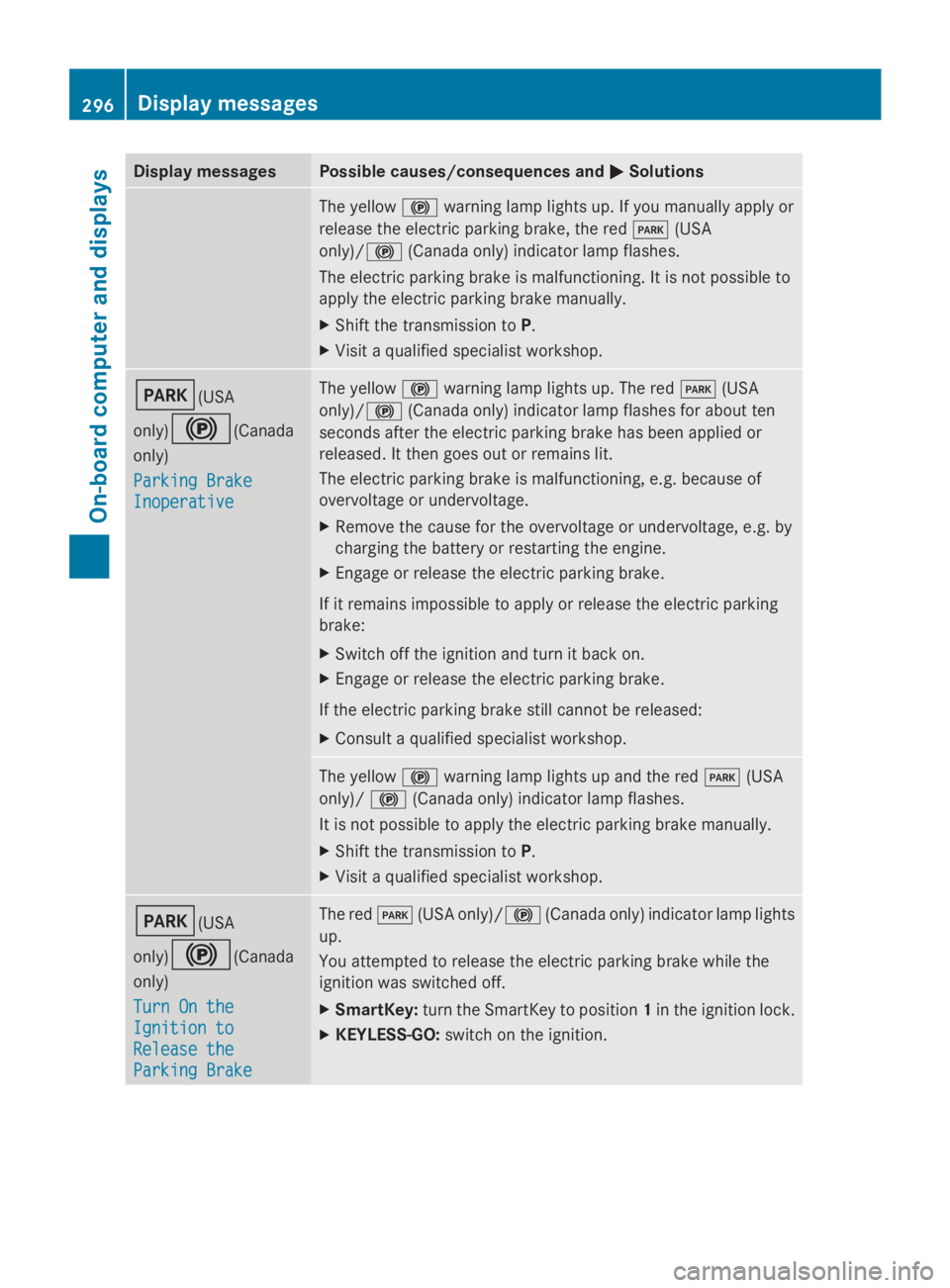
Display messagesPossible causes/consequences and�P�PSolutions
The yellow�$warning lamp lights up. If you manually apply or
release the electric parking brake, the red�I(USA
only)/�$(Canada only) indicator lamp flashes.
The electric parking brake is malfunctioning. It is not possible to
apply the electric parking brake manually.
XShift the transmission toP.
XVisit a qualified specialist workshop.
�I(USA
only)�$(Canada
only)
Parking BrakeParking Brake
InoperativeInoperative
The yellow�$warning lamp lights up. The red�I(USA
only)/�$(Canada only) indicator lamp flashes for about ten
seconds after the electric parking brake has been applied or
released. It then goes out or remains lit.
The electric parking brake is malfunctioning, e.g. because of
overvoltage or undervoltage.
XRemove the cause for the overvoltage or undervoltage, e.g. by
charging the battery or restarting the engine.
XEngage or release the electric parking brake.
If it remains impossible to apply or release the electric parking
brake:
XSwitch off the ignition and turn it back on.
XEngage or release the electric parking brake.
If the electric parking brake still cannot be released:
XConsult a qualified specialist workshop.
The yellow�$warning lamp lights up and the red�I(USA
only)/�$(Canada only) indicator lamp flashes.
It is not possible to apply the electric parking brake manually.
XShift the transmission toP.
XVisit a qualified specialist workshop.
�I(USA
only)�$(Canada
only)
Turn On theTurn On the
Ignition toIgnition to
Release theRelease the
Parking BrakeParking Brake
The red�I(USA only)/�$(Canada only) indicator lamp lights
up.
You attempted to release the electric parking brake while the
ignition was switched off.
XSmartKey:turn the SmartKey to position1in the ignition lock.
XKEYLESS-GO:switch on the ignition.
296Displaymessages
On-b oard computer and displays
Page 299 of 462
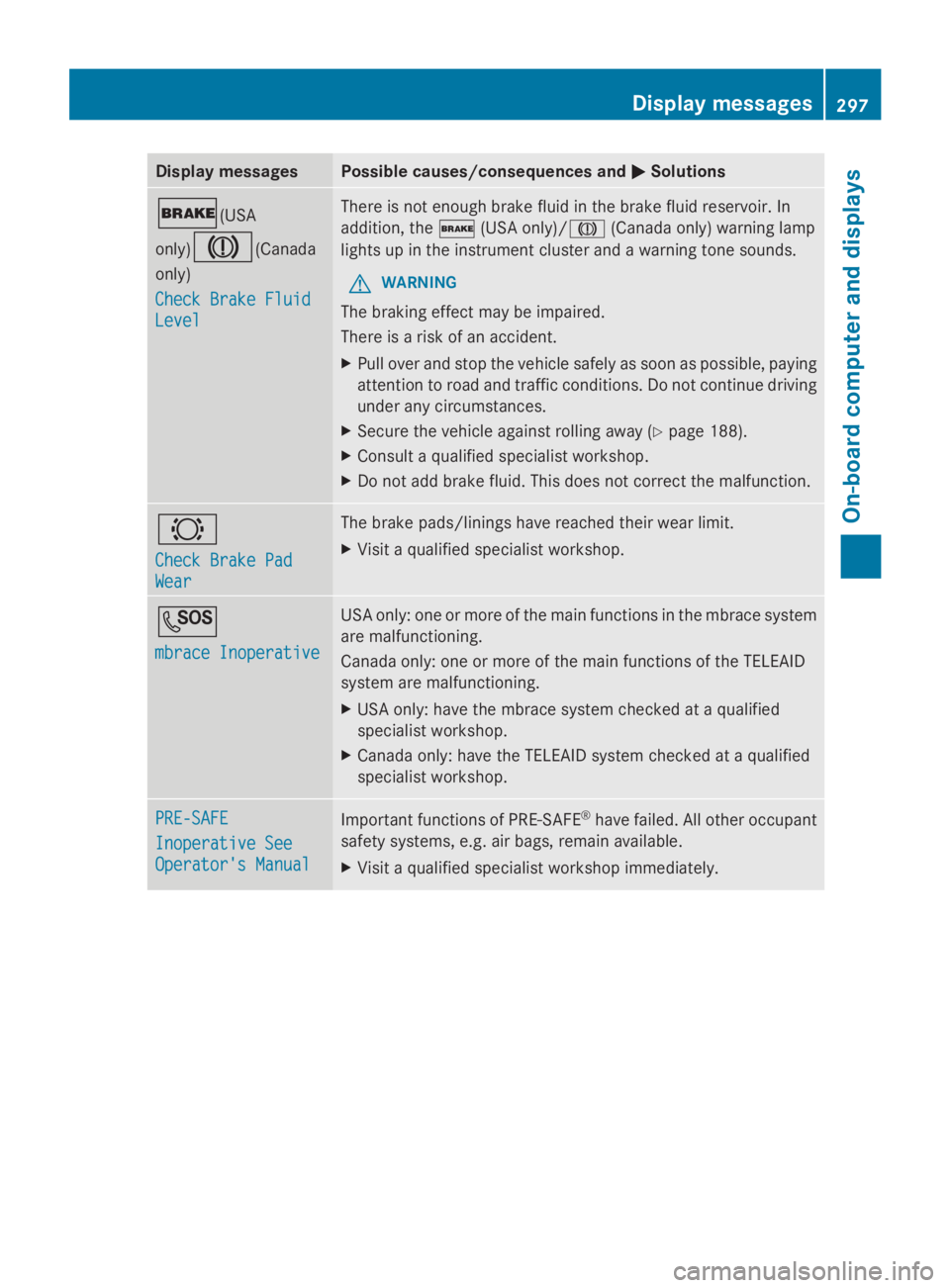
Display messagesPossible causes/consequences and�P�PSolutions
�'(USA
only)�M(Canada
only)
Check Brake FluidCheck Brake Fluid
LevelLevel
There is not enough brake fluid in the brake fluid reservoir. In
addition, the�'(USA only)/�M(Canada only) warning lamp
lights up in the instrument cluster and a warning tone sounds.
GWARNING
The braking effect may be impaired.
There is a risk of an accident.
XPull over and stop the vehicle safely as soon as possible, paying
attention to road and traffic conditions. Do not continue driving
under any circumstances.
XSecure the vehicle against rolling away (Ypage 188).
XConsult a qualified specialist workshop.
XDo not add brake fluid. This does not correct the malfunction.
�&
Check Brake PadCheck Brake Pad
WearWear
The brake pads/linings have reached their wear limit.
XVisit a qualified specialist workshop.
�S
mbrace Inoperativembrace Inoperative
USA only: one or more of the main functions in the mbrace system
are malfunctioning.
Canada only: one or more of the main functions of the TELEAID
system are malfunctioning.
XUSA only: have the mbrace system checked at a qualified
specialist workshop.
XCanada only: have the TELEAID system checked at a qualified
specialist workshop.
PRE-SAFEPRE-SAFE
Inoperative SeeInoperative See
Operator's ManualOperator's Manual
Important functions of PRE-SAFE®have failed. All other occupant
safety systems, e.g. air bags, remain available.
XVisit a qualified specialist workshop immediately.
Displaymessages297
On-b oard computer and displays
Z
Page 300 of 462
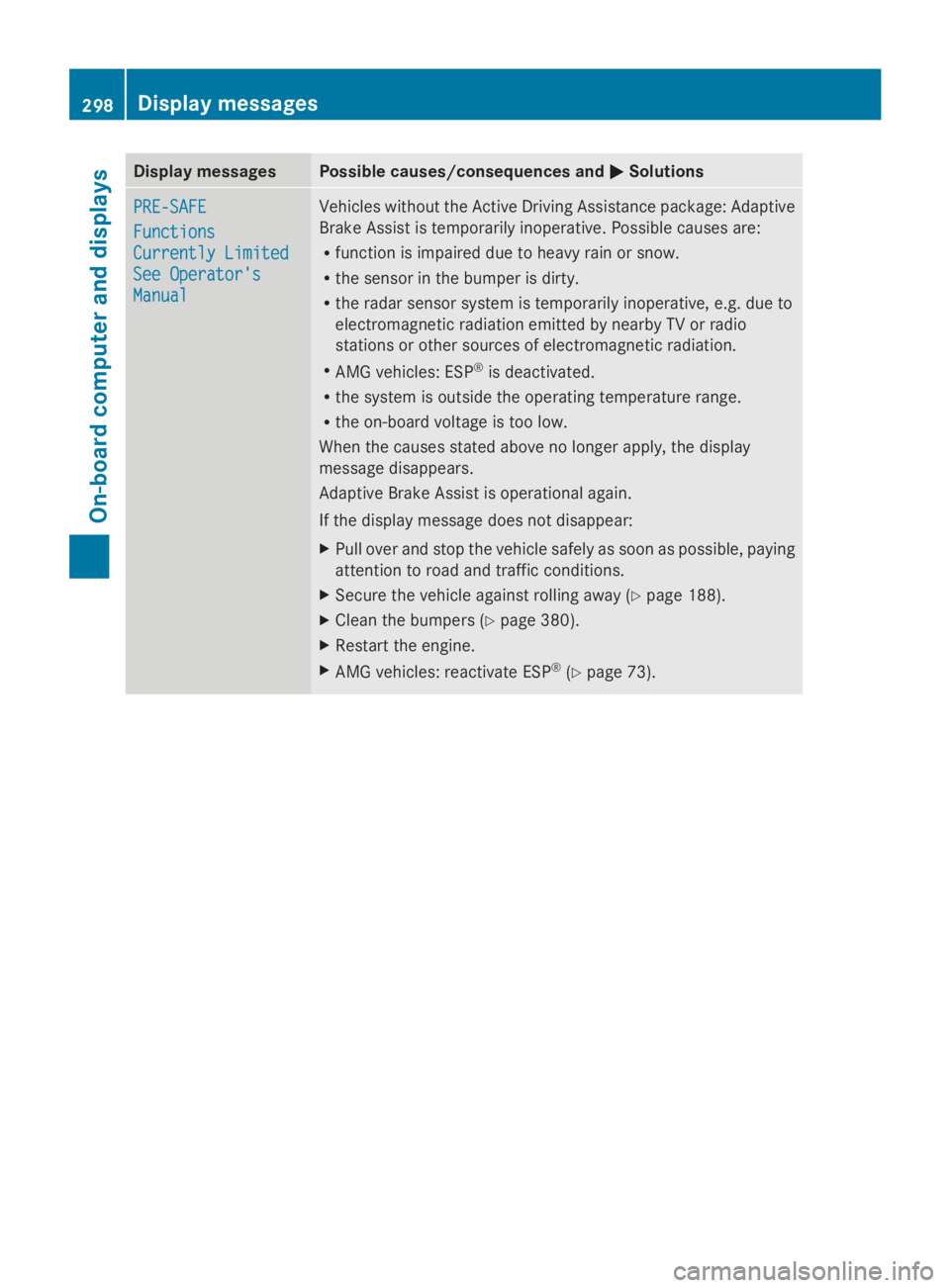
Display messagesPossible causes/consequences and�P�PSolutions
PRE-SAFEPRE-SAFE
FunctionsFunctions
Currently LimitedCurrently Limited
See Operator'sSee Operator's
ManualManual
Vehicles without the Active Driving Assistance package: Adaptive
Brake Assist is temporarily inoperative. Possible causes are:
Rfunction is impaired due to heavy rain or snow.
Rthe sensor in the bumper is dirty.
Rthe radar sensor system is temporarily inoperative, e.g. due to
electromagnetic radiation emitted by nearby TV or radio
stations or other sources of electromagnetic radiation.
RAMG vehicles: ESP®is deactivated.
Rthe system is outside the operating temperature range.
Rthe on-board voltage is too low.
When the causes stated above no longer apply, the display
message disappears.
Adaptive Brake Assist is operational again.
If the display message does not disappear:
XPull over and stop the vehicle safely as soon as possible, paying
attention to road and traffic conditions.
XSecure the vehicle against rolling away (Ypage 188).
XClean the bumpers (Ypage 380).
XRestart the engine.
XAMG vehicles: reactivate ESP®(Ypage 73).
298Displaymessages
On-b oard computer and displays
Page 301 of 462
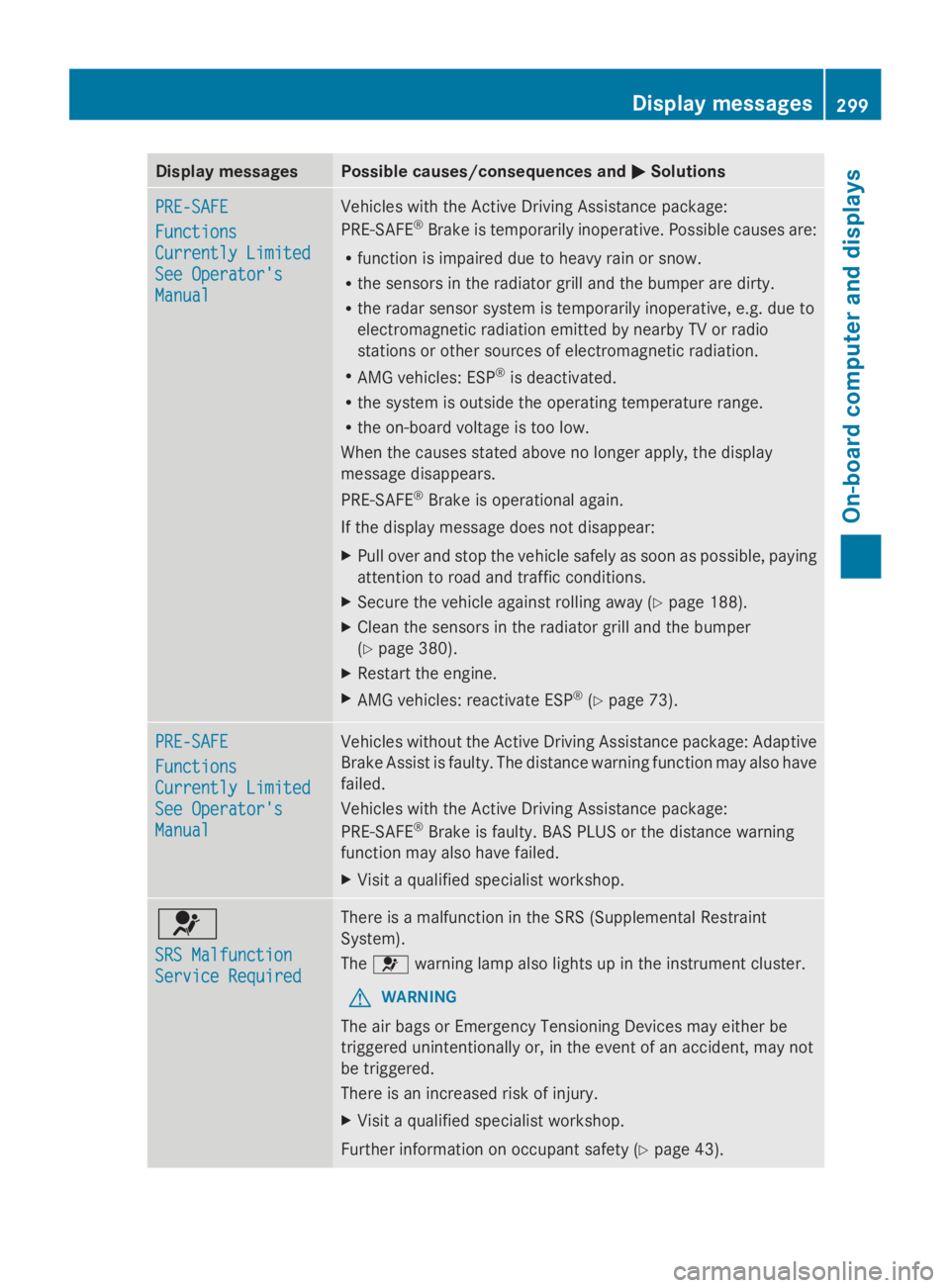
Display messagesPossible causes/consequences and�P�PSolutions
PRE-SAFEPRE-SAFE
FunctionsFunctions
Currently LimitedCurrently Limited
See Operator'sSee Operator's
ManualManual
Vehicles with the Active Driving Assistance package:
PRE-SAFE®Brake is temporarily inoperative. Possible causes are:
Rfunction is impaired due to heavy rain or snow.
Rthe sensors in the radiator grill and the bumper are dirty.
Rthe radar sensor system is temporarily inoperative, e.g. due to
electromagnetic radiation emitted by nearby TV or radio
stations or other sources of electromagnetic radiation.
RAMG vehicles: ESP®is deactivated.
Rthe system is outside the operating temperature range.
Rthe on-board voltage is too low.
When the causes stated above no longer apply, the display
message disappears.
PRE-SAFE®Brake is operational again.
If the display message does not disappear:
XPull over and stop the vehicle safely as soon as possible, paying
attention to road and traffic conditions.
XSecure the vehicle against rolling away (Ypage 188).
XClean the sensors in the radiator grill and the bumper
(Ypage 380).
XRestart the engine.
XAMG vehicles: reactivate ESP®(Ypage 73).
PRE-SAFEPRE-SAFE
FunctionsFunctions
Currently LimitedCurrently Limited
See Operator'sSee Operator's
ManualManual
Vehicles without the Active Driving Assistance package: Adaptive
Brake Assist is faulty. The distance warning function may also have
failed.
Vehicles with the Active Driving Assistance package:
PRE-SAFE®Brake is faulty. BAS PLUS or the distance warning
function may also have failed.
XVisit a qualified specialist workshop.
�u
SRS MalfunctionSRS Malfunction
Service RequiredService Required
There is a malfunction in the SRS (Supplemental Restraint
System).
The�uwarning lamp also lights up in the instrument cluster.
GWARNING
The air bags or Emergency Tensioning Devices may either be
triggered unintentionally or, in the event of an accident, may not
be triggered.
There is an increased risk of injury.
XVisit a qualified specialist workshop.
Further information on occupant safety (Ypage 43).
Displaymessages299
On-b oard computer and displays
Z
Page 307 of 462
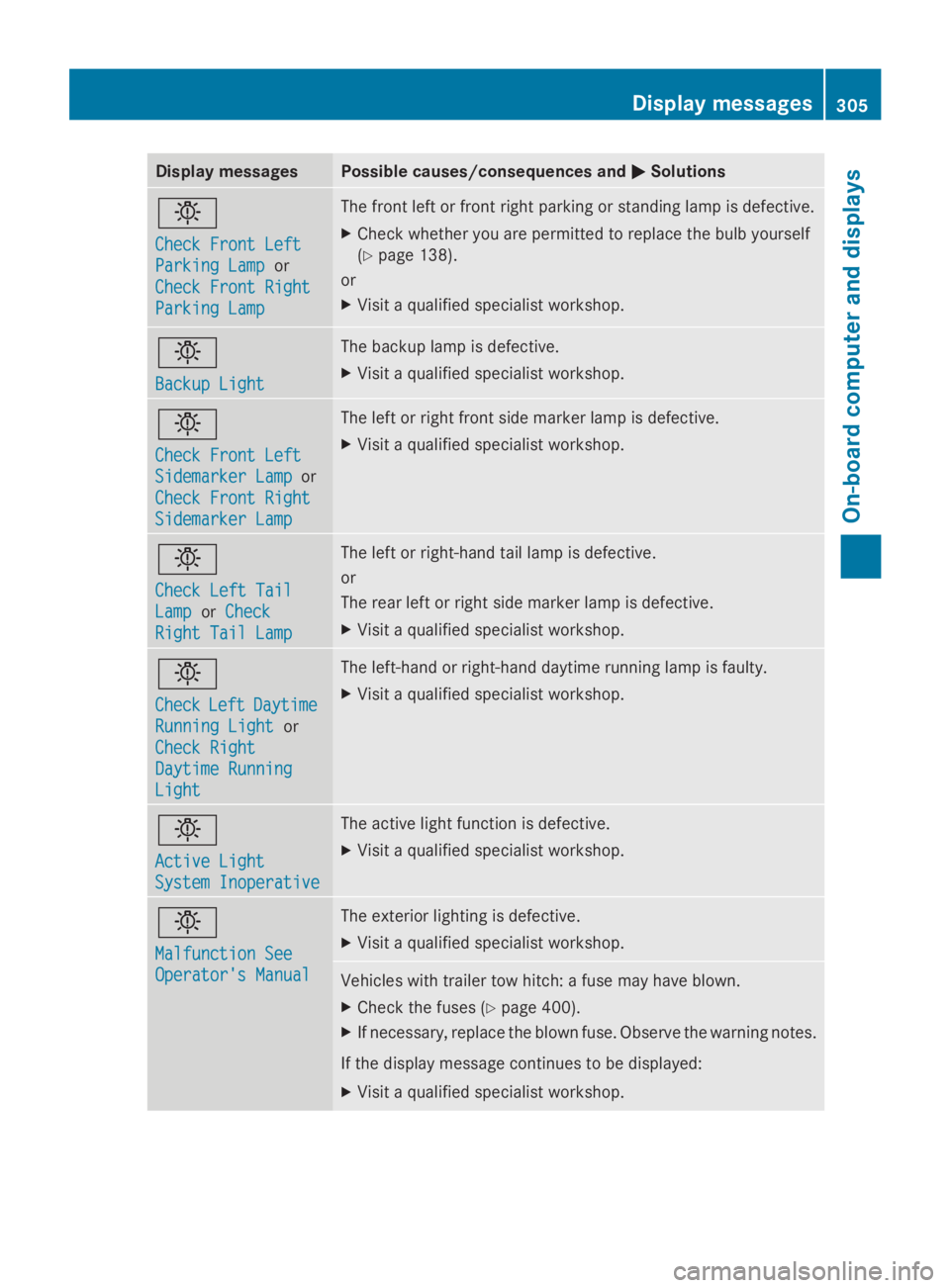
Display messagesPossible causes/consequences and�P�PSolutions
�I
Check Front LeftCheck Front Left
Parking LampParking Lampor
Check Front RightCheck Front Right
Parking LampParking Lamp
The front left or front right parking or standing lamp is defective.
XCheck whether you are permitted to replace the bulb yourself
(Ypage 138).
or
XVisit a qualified specialist workshop.
�I
Backup LightBackup Light
The backup lamp is defective.
XVisit a qualified specialist workshop.
�I
Check Front LeftCheck Front Left
Sidemarker LampSidemarker Lampor
Check Front RightCheck Front Right
Sidemarker LampSidemarker Lamp
The left or right front side marker lamp is defective.
XVisit a qualified specialist workshop.
�I
Check Left TailCheck Left Tail
LampLamporCheckCheck
Right Tail LampRight Tail Lamp
The left or right-hand tail lamp is defective.
or
The rear left or right side marker lamp is defective.
XVisit a qualified specialist workshop.
�I
CheckCheckLeftLeftDaytimeDaytime
Running LightRunning Lightor
Check RightCheck Right
Daytime RunningDaytime Running
LightLight
The left-hand or right-hand daytime running lamp is faulty.
XVisit a qualified specialist workshop.
�I
Active LightActive Light
System InoperativeSystem Inoperative
The active light function is defective.
XVisit a qualified specialist workshop.
�I
Malfunction SeeMalfunction See
Operator's ManualOperator's Manual
The exterior lighting is defective.
XVisit a qualified specialist workshop.
Vehicles with trailer tow hitch: a fuse may have blown.
XCheck the fuses (Ypage 400).
XIf necessary, replace the blown fuse. Observe the warning notes.
If the display message continues to be displayed:
XVisit a qualified specialist workshop.
Displaymessages305
On-b oard computer and displays
Z
Page 308 of 462
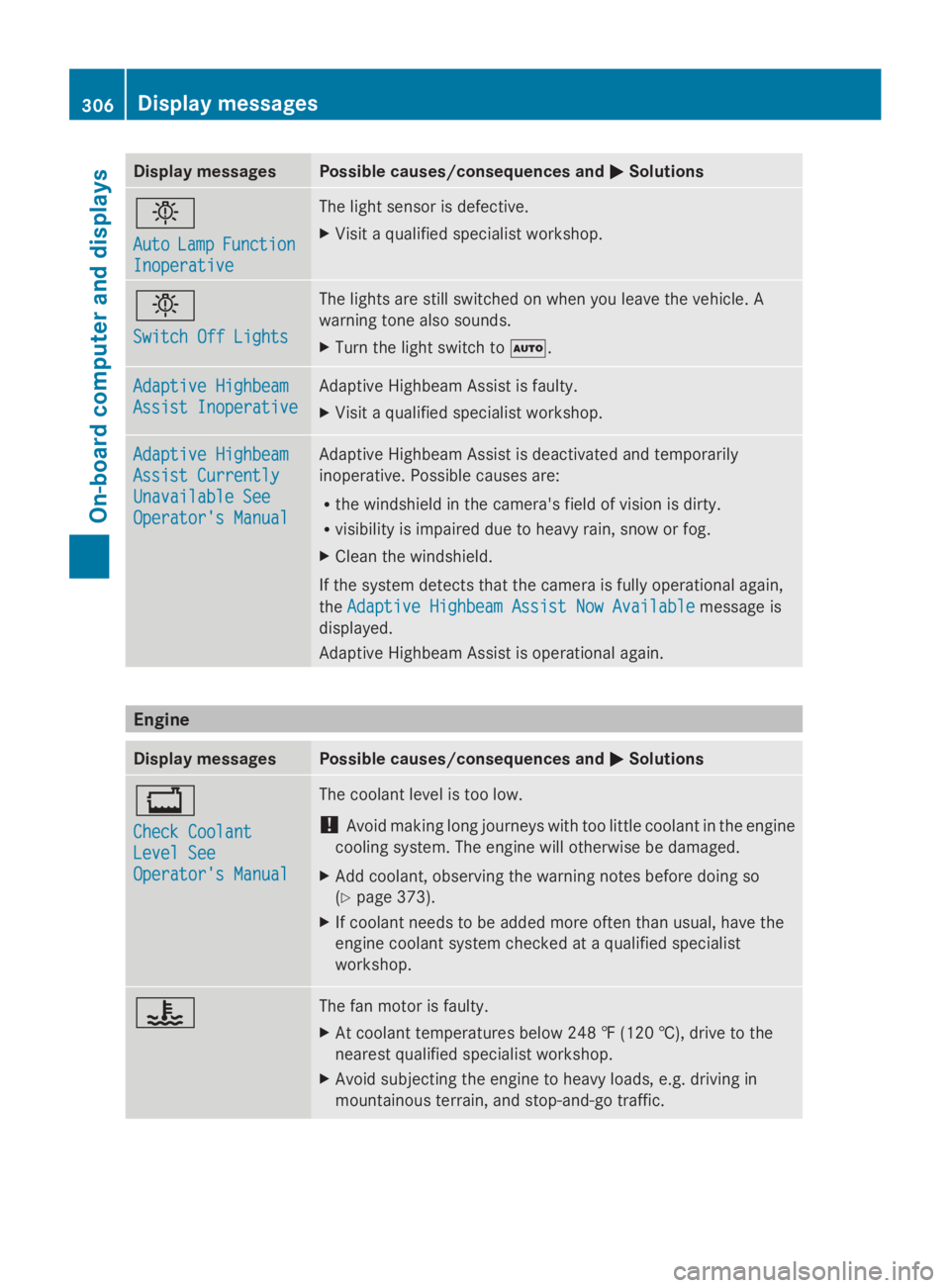
Display messagesPossible causes/consequences and�P�PSolutions
�I
AutoAutoLampLampFunctionFunction
InoperativeInoperative
The light sensor is defective.
XVisit a qualified specialist workshop.
�I
Switch Off LightsSwitch Off Lights
The lights are still switched on when you leave the vehicle. A
warning tone also sounds.
XTurn the light switch to�X.
Adaptive HighbeamAdaptive Highbeam
Assist InoperativeAssist Inoperative
Adaptive Highbeam Assist is faulty.
XVisit a qualified specialist workshop.
Adaptive HighbeamAdaptive Highbeam
Assist CurrentlyAssist Currently
Unavailable SeeUnavailable See
Operator's ManualOperator's Manual
Adaptive Highbeam Assist is deactivated and temporarily
inoperative. Possible causes are:
Rthe windshield in the camera's field of vision is dirty.
Rvisibility is impaired due to heavy rain, snow or fog.
XClean the windshield.
If the system detects that the camera is fully operational again,
theAdaptive Highbeam Assist Now AvailableAdaptive Highbeam Assist Now Availablemessage is
displayed.
Adaptive Highbeam Assist is operational again.
Engine
Display messagesPossible causes/consequences and�P�PSolutions
�